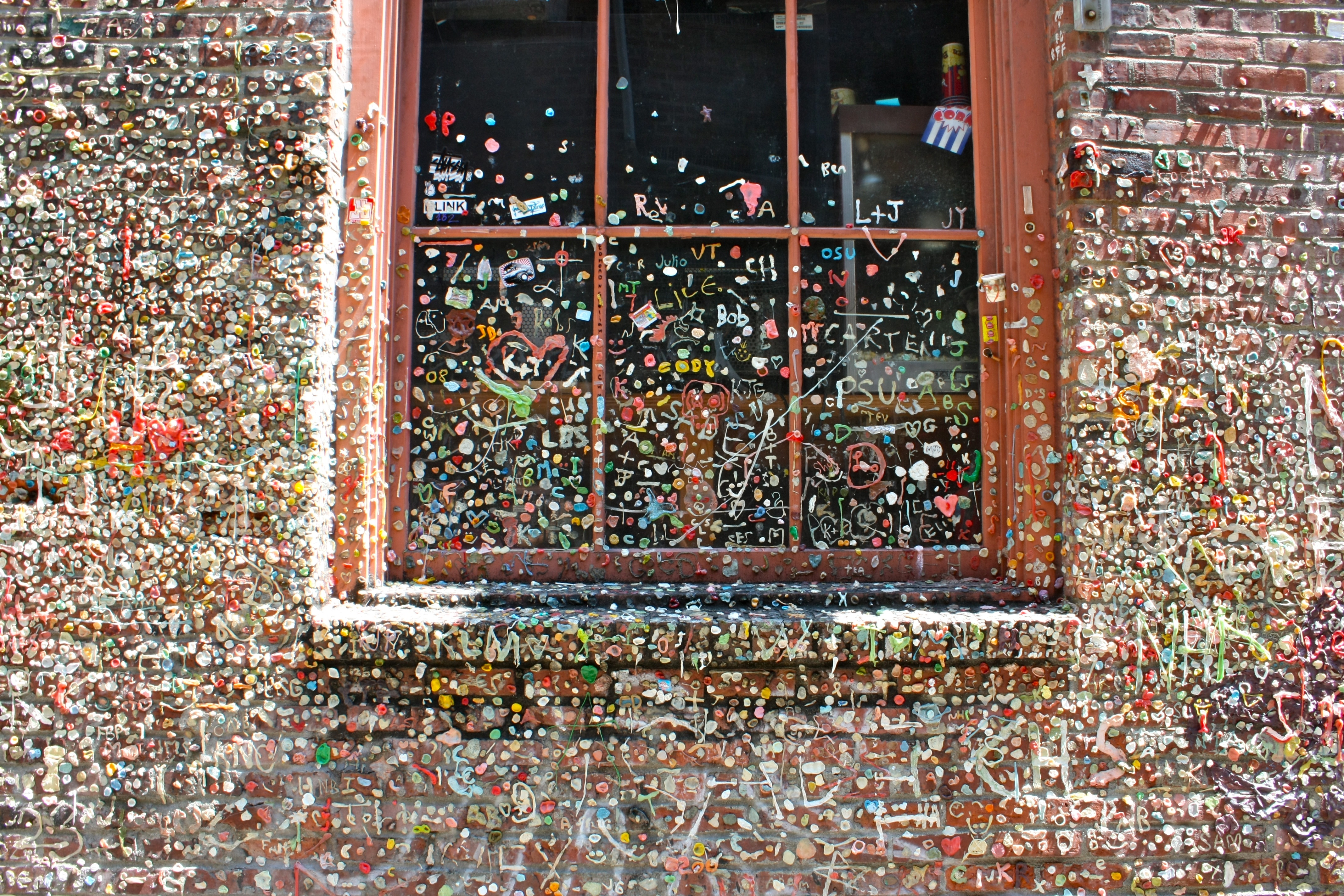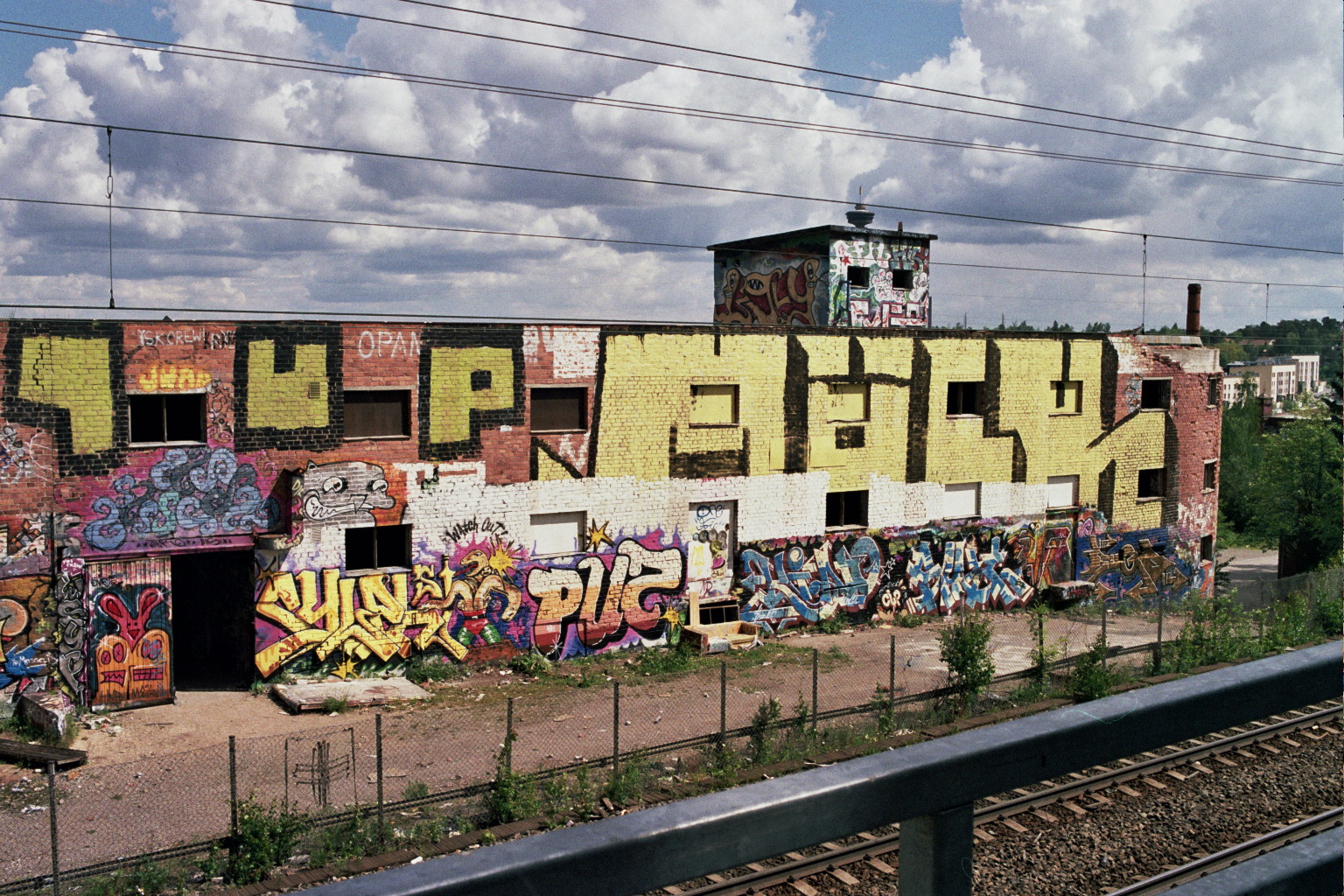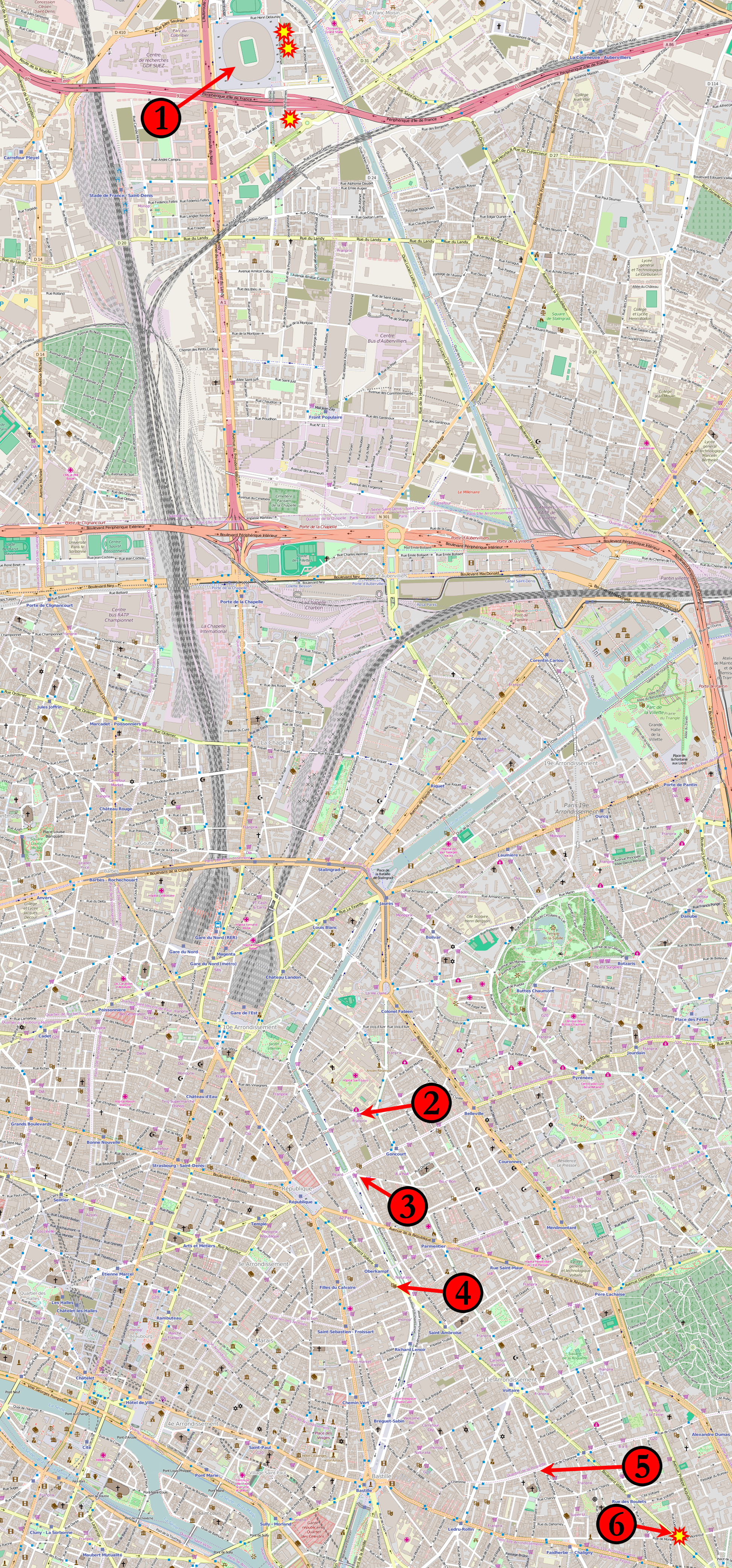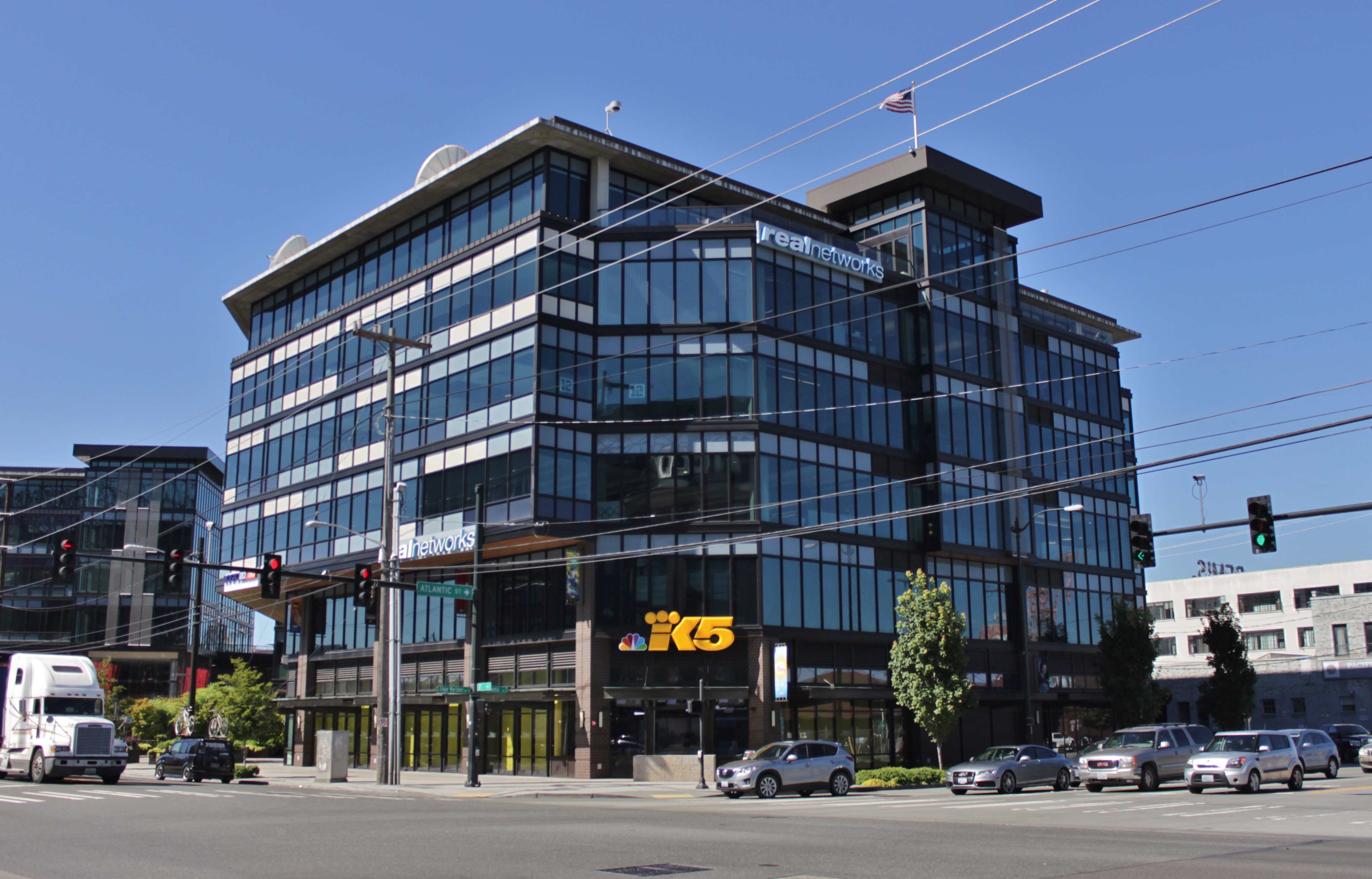|
Seattle Gum Wall
The Gum Wall is a brick wall covered in used chewing gum under Pike Place Market in Downtown Seattle. It is located on Post Alley near Pike Street, south of the market's main entrance off 1st Avenue. Parts of the gum coating alongside the walls are several inches thick, and the coating is high along a section. The Market Theater Gum Wall has become a tourist attraction and local landmark since it was unintentionally created in the 1990s. History The wall is located in Post Alley adjacent to the box office for the Market Theater, a venue for comedy shows and other small performances. After it became the host of Unexpected Productions' Theatresports in 1991, the theater's walls were covered by patrons' pieces of used gum that had Penny (U.S. coin), pennies pushed into them. The coins were later removed, but the gum remained amid several cleanings of the walls under orders from the Pike Place Market Preservation and Development Authority. The market's officials reversed course ... [...More Info...] [...Related Items...] OR: [Wikipedia] [Google] [Baidu] |
Blarney Stone
The Blarney Stone ( ga, Cloch na Blarnan) is a block of Carboniferous limestone built into the battlements of Blarney Castle, Blarney, about from Cork, Ireland. According to legend, kissing the stone endows the kisser with ''the gift of the gab'' (great eloquence or skill at flattery). The stone was set into a tower of the castle in 1446. The castle is a popular tourist site in Ireland, attracting visitors from all over the world to kiss the stone and tour the castle and its gardens. The word ''blarney'' has come to mean "clever, flattering, or coaxing talk". Irish politician John O'Connor Power defined it this way: "Blarney is something more than mere flattery. It is flattery sweetened by humour and flavoured by wit. Those who mix with Irish folk have many examples of it in their everyday experience." Letitia Elizabeth Landon described its contemporary meaning in an article entitled 'Blarney Castle' in 1832. Origins A number of stories attempt to explain the origin of the ... [...More Info...] [...Related Items...] OR: [Wikipedia] [Google] [Baidu] |
Chewing Gum
Chewing gum is a soft, cohesive substance designed to be chewed without being swallowed. Modern chewing gum is composed of gum base, sweeteners, softeners/ plasticizers, flavors, colors, and, typically, a hard or powdered polyol coating. Its texture is reminiscent of rubber because of the physical-chemical properties of its polymer, plasticizer, and resin components, which contribute to its elastic-plastic, sticky, chewy characteristics. History The cultural tradition of chewing gum seems to have developed through a convergent evolution process, as traces of this habit have arisen separately in many early civilizations. Each early precursor to chewing gum was derived from natural growths local to the region and was chewed purely out of the instinctual desire to masticate. Early chewers did not necessarily desire to derive nutritional benefits from their chewable substances but at times sought taste stimuli and teeth cleaning or breath-freshening capabilities. Chewing gum ... [...More Info...] [...Related Items...] OR: [Wikipedia] [Google] [Baidu] |
Bubblegum Alley
Bubblegum Alley is a tourist attraction in downtown San Luis Obispo, California, known for its accumulation of used bubble gum on the walls of an alley. It is a high and long alley lined with chewed gum left by passers-by. It covers a stretch of 20 meters in the 700 block of Higuera Street in downtown San Luis Obispo. History According to the San Luis Obispo Chamber of Commerce and Downtown Business Improvement Association (BIA), the origin of the gum is "a little sketchy"."Asked & Answered." New Times 11–18, Dec 1997: Some historians believe that the tradition of the alley started after WWII as a San Luis Obispo High School graduating class event.Asquith, Shirley. "Gum Alley Tour." Tolosa Times December 1997: Others believe it started in the late 1950s, as the rivalry between San Luis Obispo High School and California Polytechnic State University (Cal Poly) students. By the 1970s, Bubblegum Alley was well established. When shop owners complained that it was "unsanitary and di ... [...More Info...] [...Related Items...] OR: [Wikipedia] [Google] [Baidu] |
Graffiti
Graffiti (plural; singular ''graffiti'' or ''graffito'', the latter rarely used except in archeology) is art that is written, painted or drawn on a wall or other surface, usually without permission and within public view. Graffiti ranges from simple written words to elaborate wall paintings, and has existed Graffito (archaeology), since ancient times, with examples dating back to ancient Egypt, ancient Greece, and the Roman Empire. Graffiti is a controversial subject. In most countries, marking or painting property without permission is considered by property owners and civic authorities as defacement and vandalism, which is a punishable crime, citing the use of graffiti by street gangs to mark territory or to serve as an indicator of gang-related activities. Graffiti has become visualized as a growing urban "problem" for many cities in industrialized nations, spreading from the New York City Subway nomenclature, New York City subway system and Philadelphia in the early 1970s to ... [...More Info...] [...Related Items...] OR: [Wikipedia] [Google] [Baidu] |
Collective Action
Collective action refers to action taken together by a group of people whose goal is to enhance their condition and achieve a common objective. It is a term that has formulations and theories in many areas of the social sciences including psychology, sociology, anthropology, political science and economics. The social identity model Researchers Martijn van Zomeren, Tom Postmes, and Russell Spears conducted a meta-analysis of over 180 studies of collective action, in an attempt to integrate three dominant socio-psychological perspectives explaining antecedent conditions to this phenomenon – injustice, efficacy, and identity. In their resultant 2008 review article, an integrative Social Identity Model of Collective Action (SIMCA) was proposed which accounts for interrelationships among the three predictors as well as their predictive capacities for collective action. An important assumption of this approach is that people tend to respond to subjective states of disadvantage, whi ... [...More Info...] [...Related Items...] OR: [Wikipedia] [Google] [Baidu] |
Conceptual Art
Conceptual art, also referred to as conceptualism, is art in which the concept(s) or idea(s) involved in the work take precedence over traditional aesthetic, technical, and material concerns. Some works of conceptual art, sometimes called installations, may be constructed by anyone simply by following a set of written instructions. This method was fundamental to American artist Sol LeWitt's definition of conceptual art, one of the first to appear in print: Tony Godfrey, author of ''Conceptual Art (Art & Ideas)'' (1998), asserts that conceptual art questions the nature of art, a notion that Joseph Kosuth elevated to a definition of art itself in his seminal, early manifesto of conceptual art, ''Art after Philosophy'' (1969). The notion that art should examine its own nature was already a potent aspect of the influential art critic Clement Greenberg's vision of Modern art during the 1950s. With the emergence of an exclusively language-based art in the 1960s, however, concept ... [...More Info...] [...Related Items...] OR: [Wikipedia] [Google] [Baidu] |
Participatory Art
Participatory art is an approach to making art which engages public participation in the creative process, letting them become co-authors, editors, and observers of the work. This type of art is incomplete without viewers' physical interaction. It intends to challenge the dominant form of making art in the West, in which a small class of professional artists make the art while the public takes on the role of passive observer or consumer, i.e., buying the work of the professionals in the marketplace. Commended works by advocates who popularized participatory art include Augusto Boal in his Theater of the Oppressed, as well as Allan Kaprow in happenings. One of the earliest usages of the term appears in photographer Richard Ross's review for the Los Angeles Institute of Contemporary Art journal of the exhibition "Downtown Los Angeles Artists," organized by the Santa Barbara Contemporary Arts Forum in 1980. Describing ''in situ'' works by Jon Peterson, Maura Sheehan and Judith Sim ... [...More Info...] [...Related Items...] OR: [Wikipedia] [Google] [Baidu] |
November 2015 Paris Attacks
The November 2015 Paris attacks () were a series of coordinated Islamist terrorist attacks that took place on Friday, 13 November 2015 in Paris, France, and the city's northern suburb, Saint-Denis. Beginning at 9:15p.m., three suicide bombers struck outside the Stade de France in Saint-Denis, during an international football match, after failing to gain entry to the stadium. Another group of attackers then fired on crowded cafés and restaurants in Paris, with one of them also detonating an explosive, killing himself in the process. A third group carried out another mass shooting and took hostages at an Eagles of Death Metal concert attended by 1,500 people in the Bataclan theatre, leading to a stand-off with police. The attackers were either shot or blew themselves up when police raided the theatre. The culprits killed 130 people, including 90 at the Bataclan theatre. Another 416 people were injured, almost 100 critically. Seven of the attackers were also killed. The attac ... [...More Info...] [...Related Items...] OR: [Wikipedia] [Google] [Baidu] |
KING-TV
KING-TV (channel 5) is a television station in Seattle, Washington, United States, affiliated with NBC. It is owned by Tegna Inc. alongside Everett-licensed independent station KONG (channel 16). Both stations share studios at the Home Plate Center in the SoDo district of Seattle, while KING-TV's transmitter is located in the city's Queen Anne neighborhood. However, master control and some internal operations are based at the studios of sister station and fellow NBC affiliate WCNC-TV in Charlotte, North Carolina. Debuting as the first television station in the Pacific Northwest, channel 5 was purchased by and became the flagship station of Dorothy Bullitt's King Broadcasting Company eight months into broadcasting; the company still exists as a license holder for its properties under Tegna ownership. The station became an NBC affiliate in 1959 and has generally led the Seattle television market since. History Channel 5 first took to the air as KRSC-TV on November 25 ... [...More Info...] [...Related Items...] OR: [Wikipedia] [Google] [Baidu] |
Steam Cleaning
Steam cleaning involves using steam for cleaning. Its uses include domestic applications in cleaning flooring and household dirt removal, and industrial uses in removing grease and dirt from engines. Use Steam cleaning is not suited for all materials, such as materials which are vapor-sensitive or sensitive for high temperatures. Some examples include silk, some types of plastic, leather, paper, wallpaper and water-based paint. Environmental friendliness When used without soap, detergents, or other cleaning products, steam cleaning is an eco-friendly way of cleaning. Bacteria Steam cleaning is effective in eliminating 99.9% of bacteria, and is considered a modern way to clean home air-conditioners. Use in self-cleaning ovens In ovens, steam cleaning is an alternative to catalysis and pyrolysis for making a self-cleaning oven, and uses a lower temperature (approximately 100 celsius) compared to catalysis (approx. 200 celsius) and pyrolysis (approx. 500 celsius). See als ... [...More Info...] [...Related Items...] OR: [Wikipedia] [Google] [Baidu] |
Pont Des Arts
The Pont des Arts or Passerelle des Arts is a pedestrian bridge in Paris which crosses the River Seine. It links the Institut de France and the central square (''cour carrée'') of the Palais du Louvre, (which had been termed the "Palais des Arts" under the First French Empire). History Between 1802 and 1804, under the government of Napoleon Bonaparte, a nine-arch metallic bridge for pedestrians was constructed at the location of the present day Pont des Arts: this was the first metal bridge in Paris. The engineers Louis-Alexandre de Cessart and Jacques Dillon initially conceived of a bridge which would resemble a suspended garden, with trees, banks of flowers, and benches. Passage across the bridge at that time cost one '' sou''. On 17 March 1975, the French Ministry of Culture listed the Pont des Arts as a national historic monument. In 1976, the Inspector of Bridges and Causeways (''Ponts et Chaussées'') reported several deficiencies on the bridge. More specifically, he ... [...More Info...] [...Related Items...] OR: [Wikipedia] [Google] [Baidu] |







